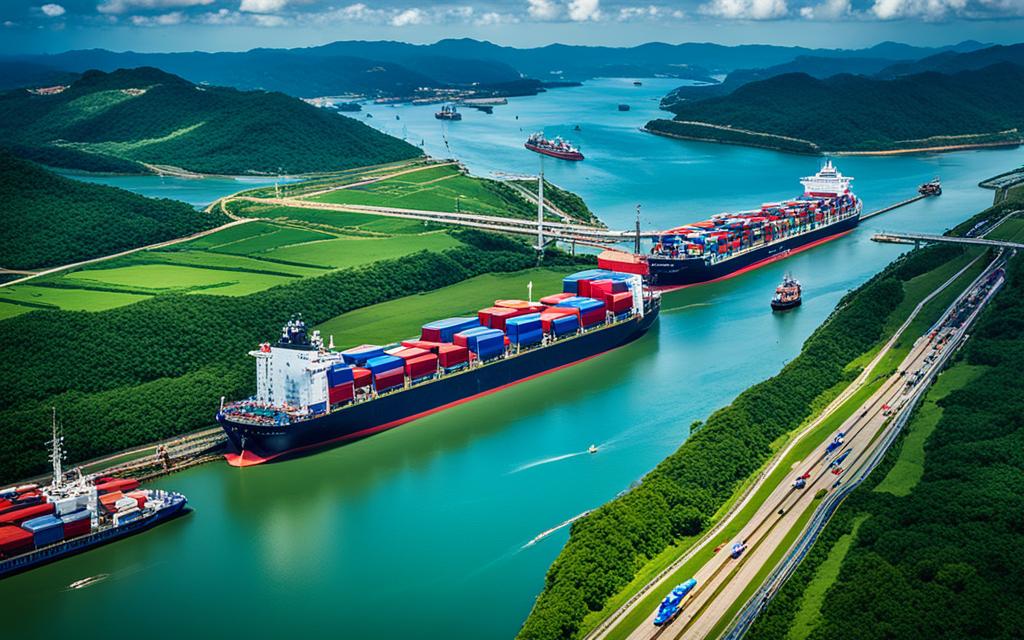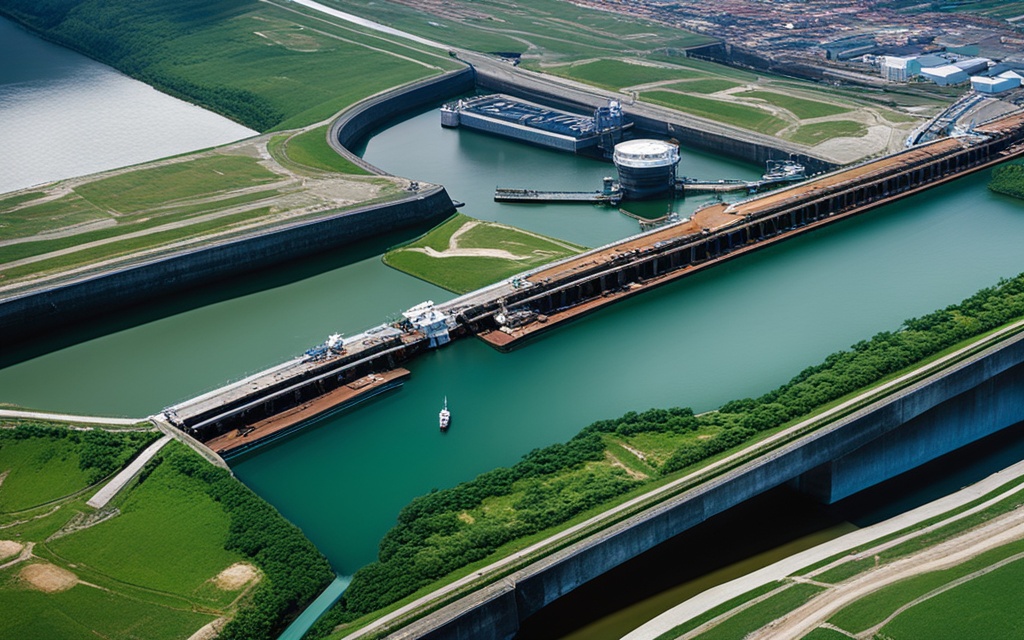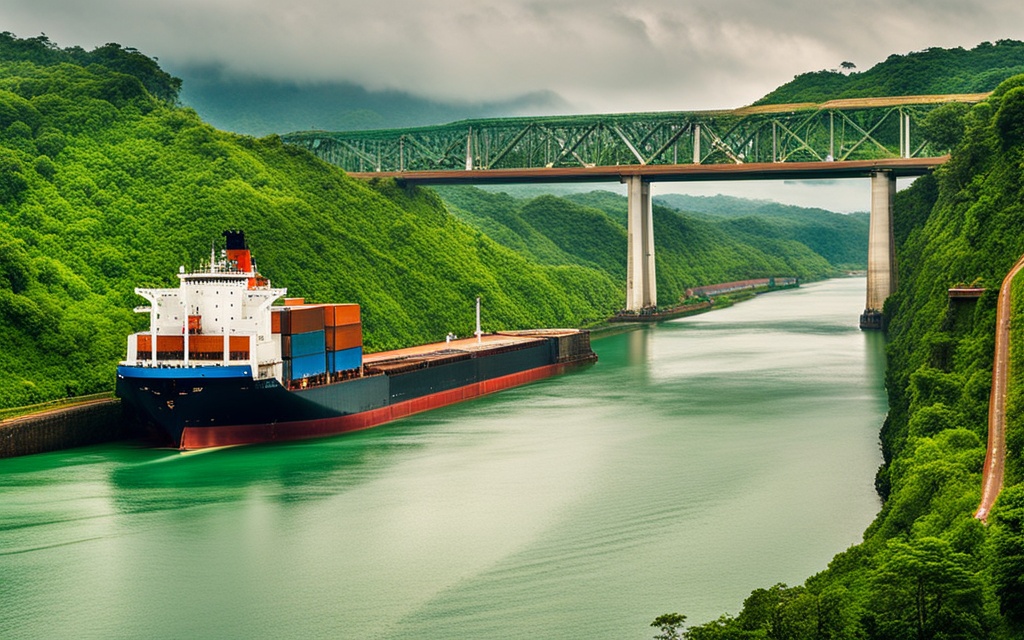The Panama Canal, a key waterway, links the Atlantic and Pacific Oceans. It’s celebrating 110 years this year. This massive project, finished by the U.S. after the French failed, changed global trade and navigation. It’s a tale of innovation, sacrifice, and teamwork.
Key Takeaways
- The Panama Canal was built by the United States after the French failed in their attempt to construct the interoceanic waterway.
- It took 10 years and $380 million to complete the canal, with 25,000 lives lost during construction.
- The canal’s opening in 1914 transformed global trade routes and navigation, establishing Panama as a vital maritime hub.
- The canal’s expansion project, completed in 2016, allowed for the passage of larger “Neopanamax” vessels, increasing its capacity and efficiency.
- The canal’s environmental challenges, such as fresh water usage and drought concerns, require ongoing attention and innovative solutions.
The Panama Canal: A Monumental Engineering Marvel
The Panama Canal’s creation showed off human engineering marvels and technological achievements. This massive project took decades and brought together teams from around the world. It changed the Latin American landscape and greatly impacted global trade and travel.
From French Failure to American Success
The French first tried to build the canal in the late 1800s but failed due to money and logistical issues. The United States took over in the early 1900s and made the project a success.
The Colossal Construction Effort and Sacrifice
Building the Panama Canal was a huge job that needed workers from all over the world. The work was tough, with diseases, bad conditions, and many deaths. Yet, the team kept going, and the canal opened in 1914, changing global trade and travel forever.
“The canal in these 110 years has represented many things. In its original construction: ingenuity, perseverance, and sacrifice; then a great struggle to recover a single national territory and a single flag,” said Ilya Espino, the route’s deputy administrator.
The Panama Canal shows what humans can do with engineering marvels and technological achievements against big challenges. Its story, from the French start to the American finish, highlights the strength of international cooperation. It shows how we can beat big obstacles together.
The Political and Economic Impact
The Panama Canal has changed global trade and navigation since it opened. In 1977, Omar Torrijos and Jimmy Carter signed treaties. These treaties led to the canal being controlled by Panama in 1999. This was a big step for Panama’s independence and sovereignty.
Panama’s Independence and the Canal Zone
For nearly a century, the U.S. controlled the Panama Canal Zone. This caused tension with Panama. But in 1999, Panama took full control of the canal. This was a victory for Panama’s desire for independence and showed its growth.
Transforming Global Trade and Navigation
The 80-kilometer route between the Pacific and Caribbean has changed maritime logistics and trade routes. The locks in the canal lift and lower ships by 26 meters. This cuts down the time and distance for ships to travel between oceans.
For instance, a ship from New York to San Francisco saves over 20,300 kilometers by using the Panama Canal. This shows the canal’s big economic impact on trade and navigation.
| Route | Distance Saved |
|---|---|
| New York to San Francisco | 20,300 km |
| London to Tokyo | 12,000 km |
| Rotterdam to Yokohama | 8,000 km |
The Panama Canal has changed the world. It’s a key latin american landmark and global trade route for over a century.
110 Years of the Panama Canal
The Panama Canal, a remarkable feat of engineering, has been open for over a century. It was opened in 1914 and has been key in global trade and transportation ever since. Despite some challenges, it has stayed strong and open through its history.
For the past 110 years, the canal shut down only twice: once in 1915 due to a landslide, and again in 1989 because of the US invasion of Panama. Even during the COVID-19 pandemic, it kept running without pause. Juan Carlos Varela, the former President of Panama, said, “We beat the Covid pandemic without stopping trade for a single day.”
The canal’s ability to adapt and stay strong has kept it as a key Latin American landmark and a key link in global trade. As the world changes, the Panama Canal shows the impact of human creativity and the lasting value of strategic infrastructure in linking the global economy.
The Expansion Project: Accommodating Larger Ships
The Panama Canal has changed a lot to meet the needs of the growing maritime industry. By the start of the 2000s, it was too small for the new big cargo ships. So, a big expansion project began in 2007 and finished in 2016. This project showed off the amazing engineering and technology of this important waterway.
The Neopanamax Vessels and Increased Capacity
The expansion lets the Panama Canal handle the new neopanamax ships, which are much bigger than before. These huge ships can be as wide as 49 meters and as long as 366 meters, almost as big as four football fields. Now, the canal can carry ships with up to 18,000 containers, as Jorge Quijano, the former Panama Canal administrator, said.
“The expansion has allowed accommodating ships of up to almost 18,000 containers.”
This big change has made global trade more efficient and cheaper. The Panama Canal is now a key part of the world’s trade network. It connects countries through its strategic location.
The Environmental Challenges
The Panama Canal is now 110 years old and faces a big environmental challenge. It needs a lot of freshwater, which is getting scarce in the area. Unlike the Suez Canal, it uses freshwater, not saltwater.
Ricaurte Vásquez, the Panama Canal’s administrator, says it uses a lot of freshwater. It’s like using the water of a city the size of New York. Every ship that goes through the canal uses about 200 million liters of freshwater, which is a big strain on the environment.
Fresh Water Usage and Drought Concerns
In 2023, a severe drought hit the Panama Canal hard. It had to cut the daily ship traffic from 38 to just 22. Now, things are getting better, but the worry about water is still there.
“Many countries have oil or gas, we have water and nature is playing a trick on us that we didn’t expect,” said Jorge Pitti, the operations manager of the Cocolí lock on the Pacific side of the route.
The Panama Canal’s use of freshwater and its risk from drought show we need to find sustainable solutions. This is crucial for keeping the canal open for global trade. Now, finding ways to make the canal sustainable is key. This means working together to solve these big problems.
| Freshwater Usage | Drought Concerns |
|---|---|
| The Panama Canal uses 2.5 times the amount of freshwater used by a city the size of New York. | In 2023, drought conditions forced the reduction of daily ship traffic from 38 to 22. The situation is slowly recovering, but water scarcity remains a pressing concern. |
| Each ship that passes through the canal consumes approximately 200 million liters of freshwater. | “Many countries have oil or gas, we have water and nature is playing a trick on us that we didn’t expect,” said Jorge Pitti, operations manager of the Cocolí lock. |
110 Years of the Panama Canal: Connecting the World
Since 1914, the Panama Canal has been key to global trade and shipping. It’s an engineering wonder that connects major shipping paths. It helps move goods across continents. Today, it’s still a key part of international trade.
The Panama Canal moves 6% of the world’s ships, touching over 1,900 ports in 170 countries. It’s a major hub for shipping and logistics. The US, China, Japan, and South Korea use it the most, showing its global importance.

The canal has changed how goods move, cutting down on time and distance between oceans. This has made trade faster and cheaper. It’s helped the world economy by making things more efficient.
“The Panama Canal has been a game-changer in the world of maritime logistics, connecting the globe and facilitating the flow of international trade for over a century.”
For 110 years, the Panama Canal has linked the world’s trade routes. It shows the power of human creativity and hard work.
The Future of the Panama Canal
The Panama Canal is now 110 years old and is looking into new ways to stay sustainable. One big problem is finding enough water, which is key to its future. This issue could affect the canal’s role in global trade.
Securing New Water Sources for Sustainability
Officials are thinking about building a reservoir near a river to meet the canal’s water needs. But, this idea faces hurdles, like moving over 2,000 people from their homes.
“The canal has to recover its service reliability. That is only achieved by securing new water sources,” warned Ricaurte Vásquez Morales, the administrator of the Panama Canal Authority.
The Panama Canal’s future depends on keeping its water resources sustainable. With climate change, it must adapt to keep supporting global trade for the future.
| Challenges | Proposed Solutions |
|---|---|
| Fresh Water Usage and Drought Concerns | Building a reservoir on a nearby river to supply the canal |
| Relocation of Affected Residents | Addressing the needs of over 2,000 people who would need to be relocated |
| Ensuring Service Reliability | Securing new water sources to maintain the canal’s operations |
Ensuring the Panama Canal’s future is a big task that needs a wide-ranging solution. It must tackle environmental issues to keep being a key part of global trade. As the world changes, the Panama Canal must innovate to stay important.
The Engineering Ingenuity Behind the Locks
The Panama Canal is an engineering wonder that has amazed people for over a century. It shows how human innovation and technology can come together. At its core, the canal’s lock system is a masterpiece. It lets ships move smoothly from the Pacific Ocean to the Caribbean Sea.
This 80-kilometer path is thanks to a series of locks. These “elevators” lift and lower ships by 26 meters. This design, full of engineering skill, has lasted for years. It helps global trade and makes the canal a key spot for commerce.
| Key Engineering Features of the Panama Canal Locks |
|---|
|
The locks of the Panama Canal show off human engineering’s power. These achievements amaze and motivate us. They prove the strength of innovation and the creation of engineering marvels.

“The Panama Canal is not just a waterway; it’s a testament to the human spirit, a triumph of engineering over nature, and a symbol of global connectivity.”
The Economic Contributions and Panamanian Pride
The Panama Canal is a true marvel of engineering. It’s a vital economic engine for the country. Since its completion 110 years ago, it has brought immense panamanian pride. It has also been a big part of the nation’s economic impact.
Today, the canal makes up 6% of Panama’s GDP. It has given over $25.7 billion to the treasury since 2000. In 2023, it hit a record high of $2.544 billion, more than the $1.878 billion during the 85 years under American rule.
The canal’s impact goes beyond money. It has changed latin american landmarks and global trade. It has made Panama a key spot for international trade and logistics. The country’s location and the canal’s modern infrastructure are crucial for global trade.
“The canal has to recover its service reliability. That is only achieved by securing new water sources,” Quijano warned.
As the canal marks its second century, Panamanian leaders aim for its continued success. They are investing in expansion and green projects. These efforts are key to meeting the maritime industry’s needs and keeping the canal top-notch.
The Panama Canal’s legacy shows the creativity, hard work, and panamanian pride of those who work on it. As the world changes, the canal will keep driving economic impact and symbolizing latin american landmarks. It will continue to be a key player for many years.
Conclusion
The Panama Canal is a true engineering wonder, changing global trade and navigation since 1914. It started with the French but was finished by the Americans. This huge project helped Panama gain independence and created the Canal Zone.
Over the last 110 years, the canal has grown to fit bigger ships and tackle issues like water use and drought. Looking ahead, finding new water sources is key to keeping the canal running. This will help Panama’s economy and keep the country proud.
The Panama Canal shows what we can do when we work together and never give up. It’s a key spot in Latin America, affecting trade, shipping, and the economy. The canal’s ongoing updates and its effect on Panama’s identity bring great pride to the nation.



